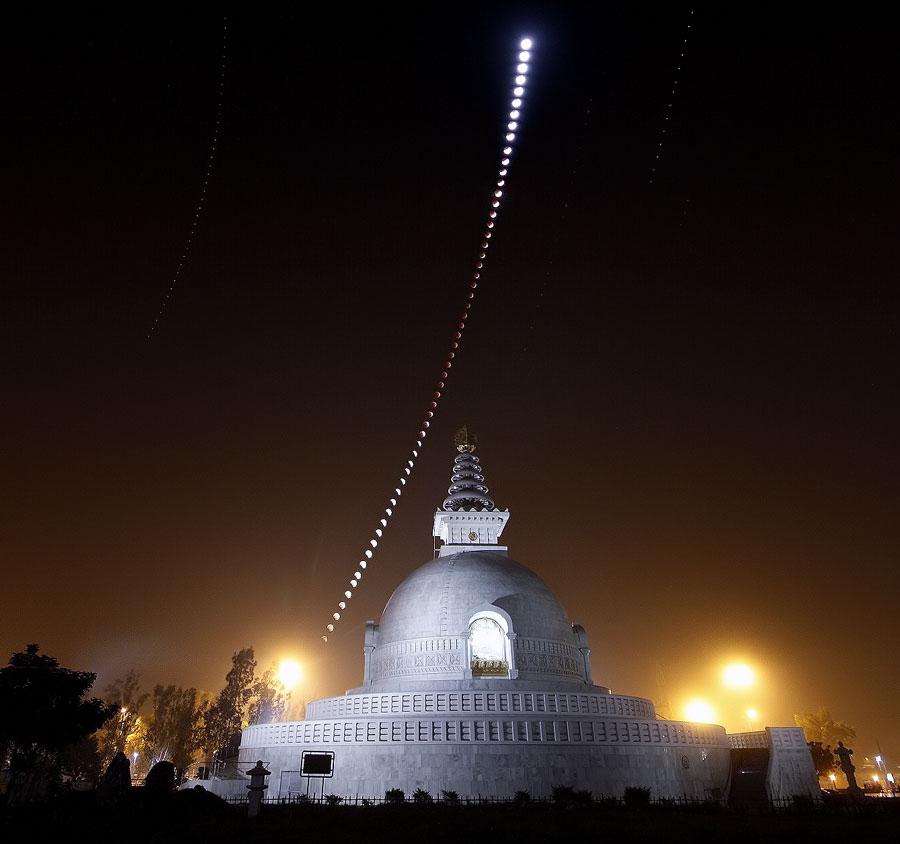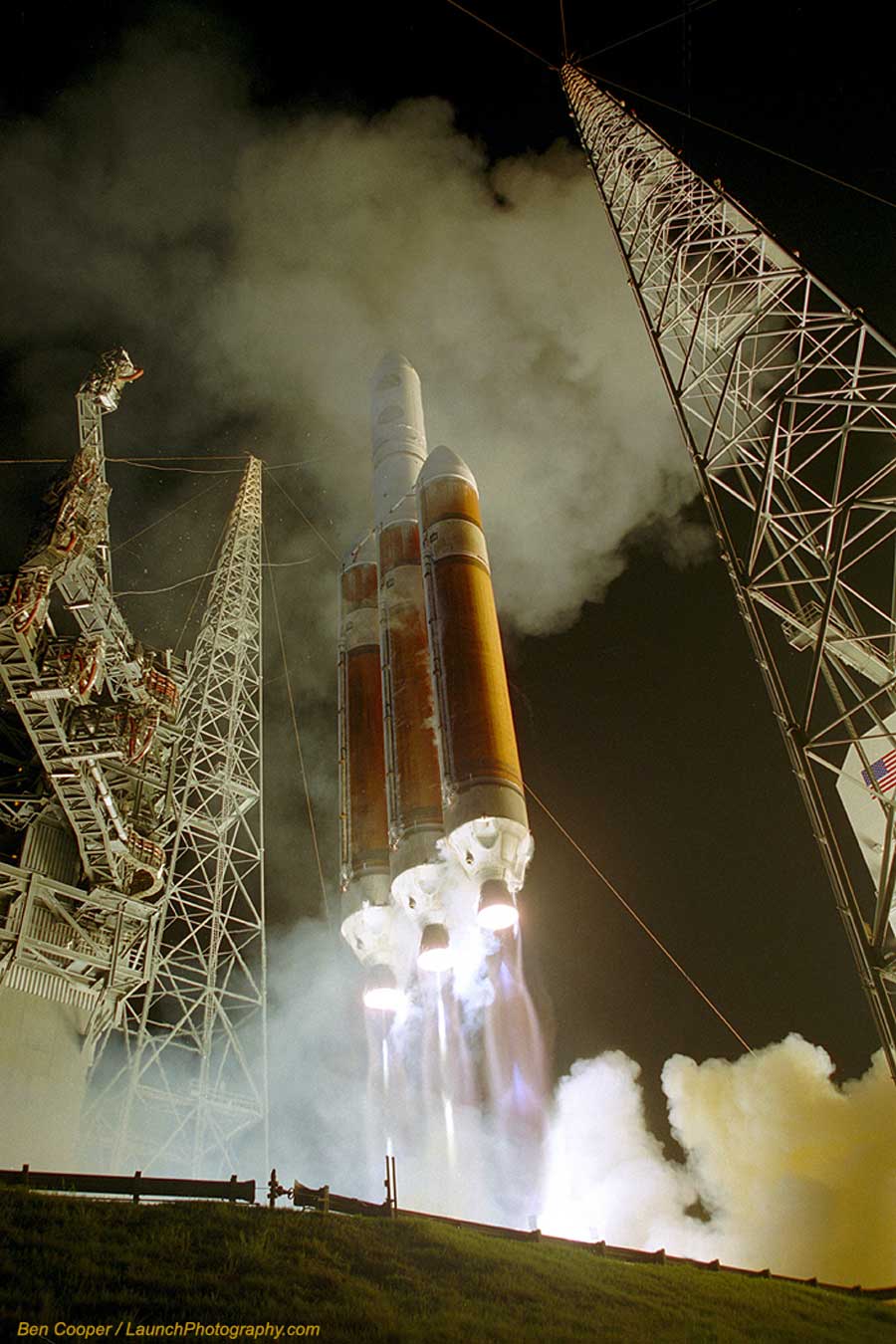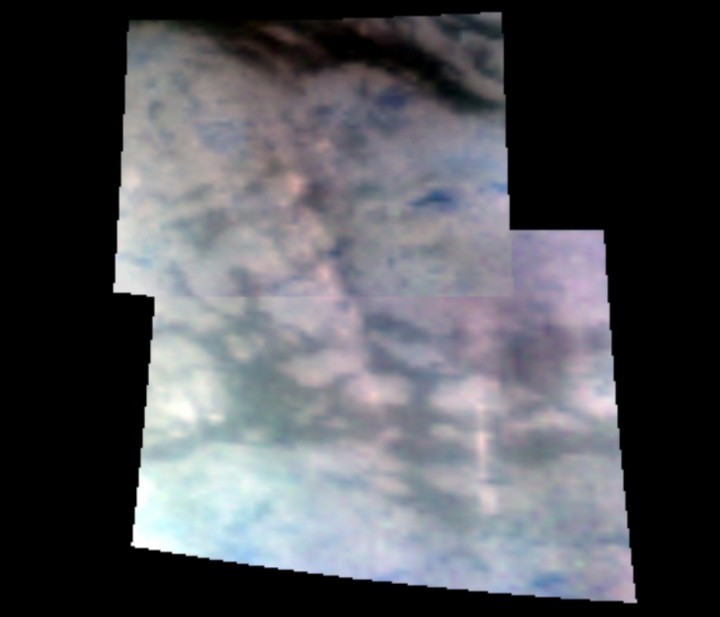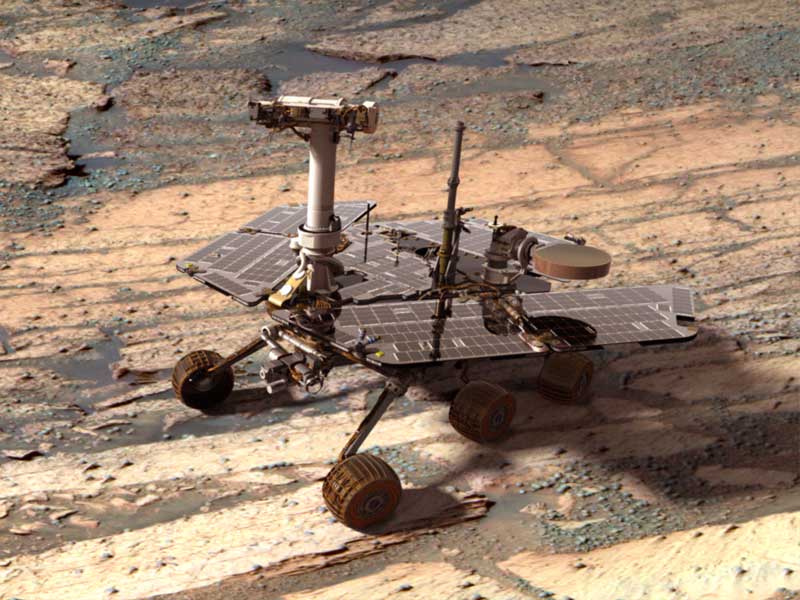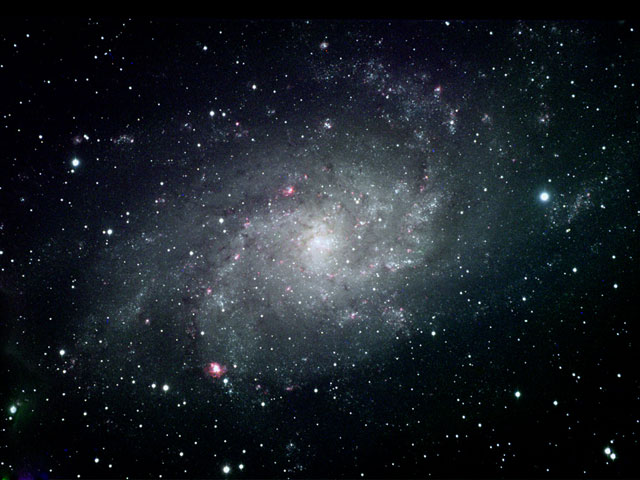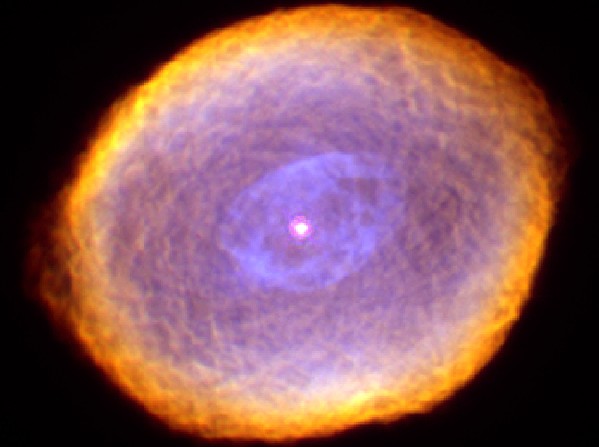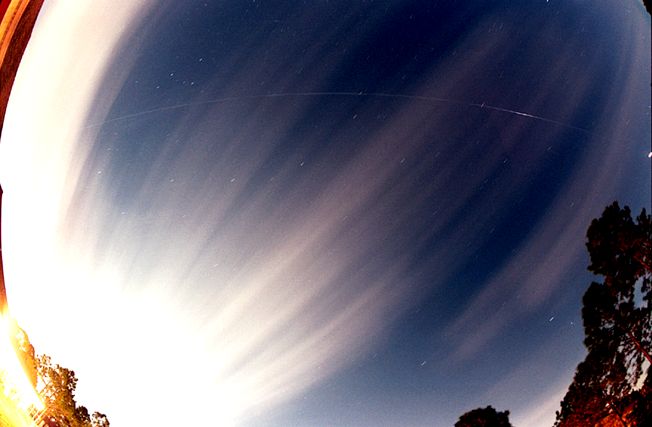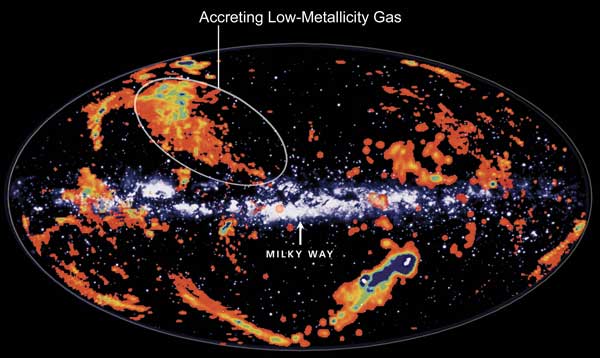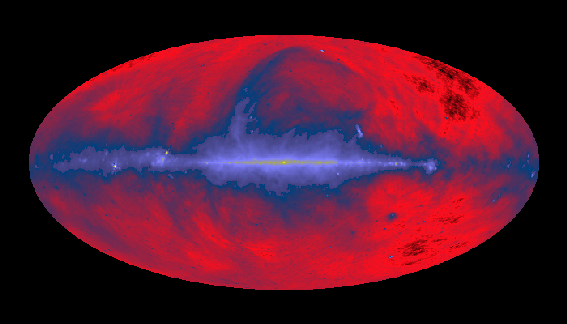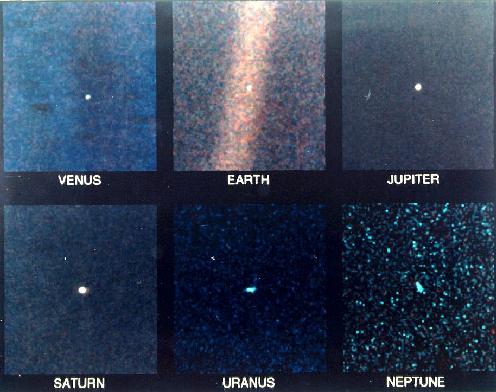| << Previous | Index | Next >> |
2014 Where did all the stars go? What used to be considered a hole in the sky is now known to astronomers as a dark molecular cloud. Here, a high concentration of dust and molecular gas absorb practically all the visible light emitted from background stars. The eerily dark surroundings help make the interiors of molecular clouds some of the coldest and most isolated places in the universe. One of the most notable of these dark absorption nebulae is a cloud toward the constellation Ophiuchus known as Barnard 68, pictured above. That no stars are visible in the center indicates that Barnard 68 is relatively nearby, with measurements placing it about 500 light-years away and half a light-year across. It is not known exactly how molecular clouds like Barnard 68 form, but it is known that these clouds are themselves likely places for new stars to form. In fact, Barnard 68 itself has been found likely to collapse and form a new star system. It is possible to look right through the cloud in infrared light.
2013 Blown by the wind from a massive star, this interstellar apparition has a surprisingly familiar shape. Cataloged as NGC 7635, it is also known simply as The Bubble Nebula. Although it looks delicate, the 10 light-year diameter bubble offers evidence of violent processes at work. Above and right of the Bubble's center is a hot, O star, several hundred thousand times more luminous and around 45 times more massive than the Sun. A fierce stellar wind and intense radiation from that star has blasted out the structure of glowing gas against denser material in a surrounding molecular cloud. The intriguing Bubble Nebula lies a mere 11,000 light-years away toward the boastful constellation Cassiopeia. This natural looking view of the cosmic bubble is composed from narrowband image data, also used to create a 3D model.
2012 On the morning of November 14, sky gazers from around the world gathered on this little planet to stand in the dark umbral shadow of the Moon. Of course, the Moon cast the shadow during last month's total solar eclipse, and the little planet is actually a beach on Green Island off the coast of Queensland, Australia. The picture itself, the first little planet projection of a total solar eclipse, is a digitally warped and stitched wrap-around of 8 images covering 360x180 degrees. To make it, the intrepid photographer had to remember to shoot both toward and away(!) from the eclipse during the excitement of totality. Near this little planet's horizon, the eclipsed Sun is just above center, surrounded by the glowing solar corona. Venus can be spotted in the shadow-darkened sky toward the top of the frame. At bottom right, bright star Sirius shines at the tip of an alarmingly tall tree.
2011 Our Moon turned red last week. The reason was that during December 10, a total lunar eclipse occurred. The above digitally superimposed image mosaic captured the Moon many times during the eclipse, from before the Moon entered Earth's shadow until after the Moon exited. The image sequence was recorded over a Shanti Stupa Peace Pagota near the center of New Delhi, India. The red tint of the eclipsed Moon was created by sunlight first passing through the Earth's atmosphere, which preferentially scatters blue light (making the sky blue) but passes and refracts red light, before reflecting back off the Moon. Differing amounts of clouds and volcanic dust in the Earth's atmosphere make each lunar eclipse appear differently. The next total lunar eclipse will occur only in 2014.
2010 It is the tallest rocket in active use. The Delta IV Heavy is the largest of the Delta series, packing the punch of three rocket boosters instead of the usual one. The resulting rocket, the most powerful in use by the US Air Force, is capable of lifting over 23,000 kilograms into low Earth orbit, comparable to NASA's Space Shuttle. Pictured above is the second launch of the Delta IV Heavy from Cape Canaveral, Florida, USA in 2007, and the first night launch. Complex service towers are visible to each side of the soaring rocket. The rocket successfully lifted a reconnaissance satellite to low Earth orbit. The Delta IV Heavy has since completed several more successful lift-offs, while its next launch is currently planned from Vandenberg Air Force Base, California, USA, next month.
2009 Believe it or not, this is the North Pole of Saturn. It is unclear how an unusual hexagonal cloud system that surrounds Saturn's north pole was created, keeps its shape, or how long it will last. Originally discovered during the Voyager flybys of Saturn in the 1980s, nobody has ever seen anything like it elsewhere in the Solar System. Although its infrared glow was visible previously to the Cassini spacecraft now orbiting Saturn, over the past year the mysterious hexagonal vortex became fully illuminated by sunlight for the first time during the Cassini's visit. Since then, Cassini has imaged the rotating hexagon in visible light enough times to create a time-lapse movie. The pole center was not well imaged and has been excluded. This movie shows many unexpected cloud motions, such as waves emanating from the corners of the hexagon. Planetary scientists are sure to continue to study this most unusual cloud formation for quite some time.
2008 An unusual triangle of light is visible this time of year just before dawn. Once considered a false dawn, this triangle of light is actually Zodiacal Light, light reflected from interplanetary dust particles. The triangle is clearly visible in the above image taken from New Mexico, USA, in October. A telescope truss tube assembly and observatory domes of New Mexico Skies fill the foreground of the early morning skyscape. Zodiacal dust orbits the Sun predominantly in the same plane as the planets: the ecliptic. Zodiacal light is so bright this time of year because the dust band is oriented nearly vertical at sunrise, so that the thick air near the horizon does not block out relatively bright reflecting dust. Zodiacal light is also bright for people in Earth's northern hemisphere in March and April just after sunset.
2007 In December of 1972, Apollo 17 astronauts Eugene Cernan and Harrison Schmitt spent about 75 hours on the Moon in the Taurus-Littrow valley, while colleague Ronald Evans orbited overhead. This sharp panorama is digitally stitched together from pictures taken by Cernan as he and Schmitt roamed the valley floor. Starting with a view of the imposing South Massif, scrolling the panorama to the right will reveal Schmitt and the lunar rover at the edge of Shorty Crater, near the spot where geologist Schmitt discovered orange lunar soil. The Apollo 17 crew returned with 110 kilograms of rock and soil samples, more than was returned from any of the other lunar landing sites. Now thirty five years later, Cernan and Schmitt are still the last to walk on the Moon.
2006 Peering through the thick, hazy atmosphere of Saturn's largest moon, an infrared camera onboard the Cassini spacecraft recorded this view of the tallest mountains ever seen on Titan. Captured during a flyby in late October, the high resolution, false-color mosaic shows a mountain range about 150 kilometers long and about 1.5 kilometers high - likened to the Sierra Nevada mountain range of the western United States, planet Earth. Along Titan's mountain ridges lie bright deposits, thought to be methane snow or other organic material. The icy mountains of Titan were probably formed like Earth's mid-ocean ridges, from material welling up to fill gaps created as surface tectonic plates spread apart.
2005
2004 Spiral galaxy M33 is a mid-sized member of our Local Group of Galaxies. M33 is also called the Triangulum Galaxy for the constellation in which it resides. About four times smaller (in radius) than our Milky Way Galaxy and the Andromeda Galaxy (M31), it is much larger than the many of the local dwarf spheroidal galaxies. M33's proximity to M31 causes it to be thought by some to be a satellite galaxy of this more massive galaxy. M33's proximity to our Milky Way Galaxy causes it to appear more than twice the angular size of the Full Moon, and be visible with a good pair of binoculars.
2003 Wouldn't it be fun if clouds were turtles? Wouldn't it be fun if the laundry on the bedroom chair were a friendly monster? Wouldn't it be fun if rock mesas on Mars were faces or interplanetary monuments? Clouds, though, are small water droplets, floating on air. Laundry is cotton, wool, or plastic, woven into garments. Famous Martian rock mesas known by names like the Face on Mars appear quite natural when seen more clearly, as the above recently released photo shows. Is reality boring?
Nobody knows how clouds make lightning. Nobody knows the geological history of Mars. Nobody knows why the laundry on the bedroom chair smells like root beer. Understanding reality brings more questions. Mystery and adventure are never far behind. Perhaps fun and discovery are just beginning.
2002 What is creating the strange texture of IC 418? Dubbed the Spirograph Nebula for its resemblance to drawings from a cyclical drawing tool, planetary nebula IC 418 shows patterns that are not well understood. Perhaps they are related to chaotic winds from the variable central star, which changes brightness unpredictably in just a few hours. By contrast, evidence indicates that only a few million years ago, IC 418 was probably a well-understood star similar to our Sun. Only a few thousand years ago, IC 418 was probably a common red giant star. Since running out of nuclear fuel, though, the outer envelope has begun expanding outward leaving a hot remnant core destined to become a white-dwarf star, visible in the image center. The light from the central core excites surrounding atoms in the nebula causing them to glow. IC 418 lies about 2000 light-years away and spans 0.3 light-years across. This false-color image taken from the Hubble Space Telescope reveals the unusual details.
2001 Like delicate cosmic petals, these clouds of interstellar dust and gas have blossomed 1,300 light-years away in the fertile star fields of the constellation Cepheus. Sometimes called the Iris Nebula and dutifully cataloged as NGC 7023, this is not the only nebula in the sky to evoke the imagery of flowers. Still, the beautiful digital image shows off the Iris Nebula's range of colors and symmetries in impressive detail. Within the Iris, dusty nebular material surrounds a massive, hot, young star in its formative years. Central filaments of cosmic dust glow with a reddish photoluminesence as some dust grains effectively convert the star's invisible ultraviolet radiation to visible red light. Yet the dominant color of the nebula is blue, characteristic of dust grains reflecting starlight. Dark, obscuring clouds of dust and cold molecular gas are also present and can lead the eye to see other convoluted and fantastic shapes. Infrared observations indicate that this nebula may contain complex carbon molecules known as PAHs. As shown here, the Iris Nebula is about 6 light-years across.
2000 Still under construction, the International Space Station is becoming one of the brightest, fastest moving "stars" in the heavens. Despite illuminated clouds and bright light from a nearly full moon (lower left), this 5 minute time exposure easily captures the Space Station's trail as it arcs through early evening skies above Palm Beach Gardens, Florida, USA on December 9. At the time, the Space Shuttle Endeavour had undocked and moved away from the orbiting platform, the shuttle crew having just completed the installation of large solar panels to power the Space Station's systems. Sunlight glinting off the large, shiny panels is likely the source of the brief flare visible along the track. Astrophotographer Doug Murray and colleague report that both Shuttle and Space Station were visible separately and on close inspection of this image they do produce distinct, parallel arcs. At the extreme right hand edge of the picture, the trails pass very near the brightest "star" in the night sky, Venus.
1999 Where are these gas clouds going so quickly? High velocity clouds (HVCs) of gas have been seen for decades but their origins and destinations have remained mysterious. Recent measurements have now placed at least one of these clouds in the halo of our Milky Way Galaxy, while other measurements have determined the relative abundance of cloud elements. Of the two clouds measured, each appears to have a chemical abundance consistent with a different origin. One HVC has been measured to have very few heavy elements ("low metallically") compared to neighboring stars, while another HVC has been inferred to have a heavy element abundance more typical of neighboring stars. Hypotheses are therefore being investigated that some HVCs are local gas remnants being pushed away from our Galaxy by supernova explosions, while other HVCs are ancient dwarf galaxy remnants falling toward our Galaxy. The latter possibility is particularly interesting as it might help explain how our Galaxy can continue to make stars at the observed rate. Fast moving HVCs are circled in the above false-color mosaic.
1998 Among the faintest objects are some of the most unusual objects. The Hubble Deep Field South was released after much anticipation earlier this month, delivering a unique view of some of the most distant parts of our universe. Part of this field is shown above. Numerous astronomers are currently poring over this field, trying to find clues about young galaxies, cosmological curvature, and dark matter. Clearly, visible among galaxies as dim as magnitude 30 in this long-duration exposure (and in the original Hubble Deep Field North) are many peculiar looking galaxies. One interesting artifact is the blue arc just to the upper right of the large galaxy near the image center. This arc may be light from a more distant galaxy focused by the gravitational lens effect of the nearer galaxy.
1997 Tune your radio telescope to 408MHz (408 million cycles per second) and check out the Radio Sky! You should find that frequency on your dial somewhere between US broadcast television channels 13 and 14. In the 1970s large dish antennas at three radio observatories, Jodrell Bank, MPIfR, and Parkes Observatory, were used to do just that - the data were combined to map the entire sky. Near this frequency, cosmic radio waves are generated by high energy electrons spiraling along magnetic fields. In the resulting false color image, the galactic plane runs horizontally through the center, but no stars are visible. Instead, many of the bright sources near the plane are distant pulsars, star forming regions, and supernova remnants, while the grand looping structures are pieces of bubbles blown by local stellar activity. External galaxies like Centaurus A, located above the plane to the right of center, and the LMC (below and right) also shine in the radio sky.
1996 After taking spectacular pictures of our Solar System's outer planets, Voyager 1 looked back at six planets to take our Solar System's first family portrait. Here Venus, Earth, Jupiter, Saturn, Uranus, and Neptune, were all visible across the sky. Each, however, was now just a small speck of light, dimmer than many of the stars in the sky. Voyager 1 is only one of four human-made objects to leave our Solar System, the other three being Voyager 2, and Pioneer 10 and Pioneer 11.
1995 Atlas Centaur rockets have launched over 75 successful unmanned missions. These missions included the Surveyor series - the first vehicles to make soft landings on the Moon, Pioneer 10 and 11 - the first missions to fly by Jupiter and Saturn and the first man-made objects able to leave our Solar System, the Viking missions which landed on Mars, several satellites in the High Energy Astrophysics Observatory (HEAO) series, Pioneer Venus which circled and mapped the surface of Venus, and numerous Intelsat satellites. Of recent scientific interest was the Atlas launched SOHO mission which will continually observe the Sun. Atlas rockets are manufactured by Lockheed Martin Co.
| << Previous | Index | Next >> |



